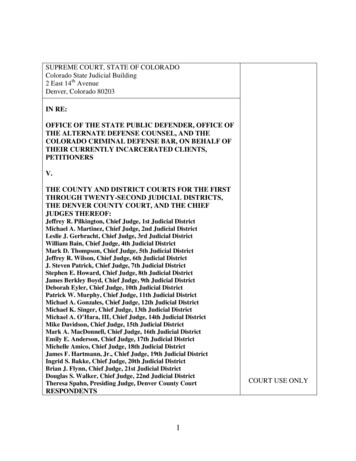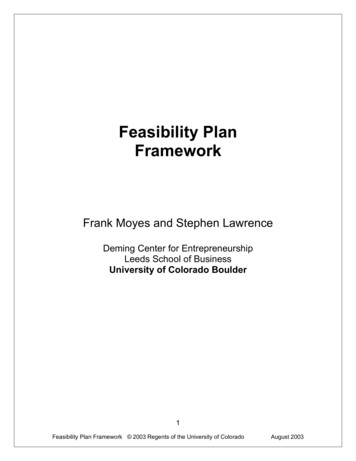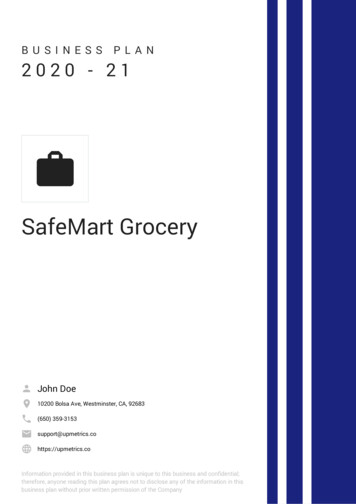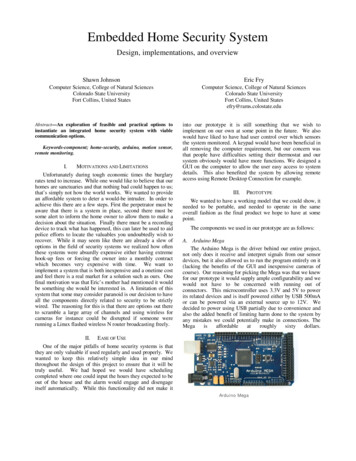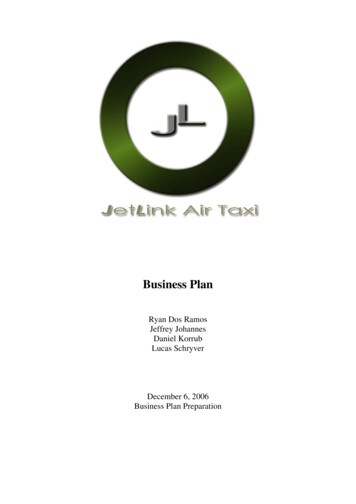
Transcription
Business PlanRyan Dos RamosJeffrey JohannesDaniel KorrubLucas SchryverDecember 6, 2006Business Plan Preparation
Table of ContentsExecutive summary. 3JetLink's Service. 4Market Analysis.5Industry Analysis .6Marketing Plan.9Operation Plan .13Development Plan . 15Management Plan .16Competitive Advantages.17Summary of Financial Projections.18Business Risks .19Funding Requirments. 20Table of Appendices .21Appendix A: Competitive Matrix.22Appendix B: Customer Survey .23Appendix C: Competitor Survey Results .24Appendix D: Detailed Income Statements . 25Appendix E: Detailed Balance Sheet .26Appendix F: Detailed Cash Flow Statements .27Appendix G: Break-Even Analysis .28Appendix H: Financial Comps .29Appendix I: COGS Breakdown .30Appendix J: Eclipse 500 Images .31JetLink Business Plan-2-
Executive SummaryWhat is JetLink?JetLink provides regional air taxi services on its ten Eclipse 500 aircraft between five majorwest coast regional airports.OpportunityEvery day, thousands of travelers waste hours and hours of time waiting at airport check-incounters, in security lines, and near baggage claim carousels. Numerous editorials andcountless customer complaints showcase the hassles of post 9/11 air travel. In fact, on a scaleof 1 to 10 survey respondents ranked their satisfaction with commercial air travel as a 5.5.The need for service improvement in the 126 billion domestic air travel market is clear.According to 2005 data from the National Business Travel Association, wealthier businesstravelers and first class flyers are searching for commercial alternatives. On the West Coastalone, these markets constitute a 2 billion opportunity.JetLink’s ServiceTraditionally, one needed to charter an entire aircraft or own a plane to fly privately. Withthe new class of cheap-to-buy, cheap-to-fly Very Light Jets (VLJ’s), JetLink offers fares forsingle seats. Using Slipstream Air’s advanced air taxi scheduling system, JetLink will offerdirect flights between Las Vegas, Sacramento, Long Beach, San Jose, and Van Nuys.How does JetLink add value?By offering flights to un-crowded regional airports with no check-in, security, or baggageclaim waits, JetLink provides a time saving alternative for today’s west coast regionalbusiness and first class travelers.Marketing StrategyBy placing print ads in local lifestyle magazines (e.g. Long Beach Magazine), directlytargeting local businesses, and handing out brochures at commercial airports, JetLink willeffectively reach its target audience and position itself as a time saving alternative tocommercial air travel without 4000/hr prices.Competitive AdvantageAlthough JetLink competes with commercial airlines, private air charters, fractional aircraftownership services, and other air taxi startups, its regional airport service, unique pricingmodel, and first mover status create competitive advantages for the company.ManagementCombining the leadership and financial skills of two aviation executives, William Hall fromCitationShares and Carl Thorsberg from Marquis Jet, along with the technical marketingknow-how of Interwoven Inc. CMO Bill Seawick, will ensure that JetLink soars to newheights.Financial ProjectionsJetLink’s year five revenue will be approximately 30 million dollars, and the companyexpects to break even after 10 months. JetLink predicts 55% gross profit margins in yearfive.JetLink Business Plan-3-
FundingJetLink plans to raise 4 million in a round of series A financing surrendering 35.7% of thecompany. Additionally, JetLink will finance 90% its aircraft with debt totaling 13.5 million.JetLink’s ServiceJetLink will offer point-to-point private jet service at roughlythe cost of traditional first class travel. Customers pay forsingle seats rather than the entire aircraft. Additionally,customers who can fly anytime during a 5-hour time windowwill pay less for ticket than customers who must fly at acertain time. Customers will then be grouped togetheraccordingly by destination and time.Initially, ten aircraft will serve the following five locations:JetLink Headquarters: North Las Vegas Airport—Las Vegas, NVSacramento Executive Airport—Sacramento, CALong Beach Airport—Long Beach, CASan Jose International Airport—San Jose, CAVan Nuys Airport—Van Nuys, CAFeatureRegional Airport Service (i.e. no check-inlines, security lines, or baggage claims)Single-seat faresDeparture from fixed base operator’s (FBO)luxurious loungeNo need to check baggageBenefitSaves travelers timeSaves travelers moneyHelps traveler relaxNo lost bagsPricingTo understand JetLink’s pricing structure, consider the following example.Customer A wants to fly from Las Vegas, NV to San Francisco, CA. Customer B also wants to fly fromLas Vegas to San Francisco. Customer A can fly next Thursday between 8:00 am and 3:00 pm.However, customer B must take off next Thursday at 9:30 am.Because ticket pricing is determined by the customer’s time window, customer A would pay 475 for his/her ticket, while customer B would pay 875 for his/her ticket.Customer’s Time WindowLess than 1 hour1-2 Hours2-3 Hours3-4 Hours4 HoursTicket Price 875 775 675 575 475JetLink Business Plan-4-
Market AnalysisFirst Class Market; Western 25% of US 1 2Total Domestic Airline Market 126 BillionAverage First Class seating per plane 7%Total Domestic First Class market 8.8 BillionWestern 25% of US market 2.2 BillionGrowth Rate 10%California Business Air Traveler Market 3 4Annual number of commercial air trips 29,621,000Percentage of travel for business in California 20%Number of business air trips 5,924,200Growth Rate less than 1%Trends in the MarketplaceAlthough the air travel market is at its highest post-9/11 level, the overall number of travelershas not yet reached its pre-9/11 state. However, potential exists in the first class market,which is growing at a faster rate. “Most of the growth is coming from high fare airlines.Over the past year and a half there has been greater demand for premium airlines.” 5Commercial air carriers are focusing more and more on features like in flight films andupgraded food service partly to overshadow the hassles of commercial air travel.Trends in the business market are harder to pinpoint, though data is revealing. Since 2000the airline industry has lost 50 percent of its normal business travelers due to extended waittimes, lack of regional service, and poor customer service levels. 6 Additionally, increasingnumbers wealthy business travelers are electing to fly privately for security reasons. NBTAsurveys show a growing use of private jets and charters since the 2001 terror attacks on theUnited States. In fact, in 2002 26% of U.S. companies used private jets. By 2004, that figurehad risen to 33%. Research from the NBTA shows the trend continuing. 7According to the North American Industry Classification System (NAICS), JetLink will beentering and competing in the Nonscheduled Chartered Passenger Service industry. Morespecifically, JetLink will be listed under the 2002 NAICS Code 481211 and theCorresponding Index Entries of an Air Taxi Service 8 .1Frost and Sullivan: North American Air Travel Report. 2005McGee, William J. Major Travel Sites Face Credibility Crunch. Consumer Reports Webwatch. March 1,20053US Bureau of Transportation Statistics. American Travel Survey. 19954Business Wire. CFO Survey Shows Rising Travel Costs. May 8, 20065Airfinance Journal. Us Airlines Triumph. Euromoney Institutional Investor PLC. July 12, 20066Knight-Ridder/Tribune Business News. Air Travel is a drag in post-9/11 world. September 6, 20067Peterson, Kyle. Airport Security Rules Become a Mere Blip for Business Travelers. Reuters August 18, 20068NAICS. 2002. North American Industry Classification System. 24 October 2006 http://www.census.gov/epcd/naics02/def/NDEF481.HTM 2JetLink Business Plan-5-
Target SegmentsJetLink will focus on two market segments:West coast, first class travelers9West coast, regional business travelers10- Annual Income 150,000 - Normally purchase first class seats- Willing to pay for convenience andexclusivity- Cannot afford 4,000 /hr to charter aprivate jet- Annual Income 100,000 - 30-49yr. old males- Travel 12 or more times/year- Cannot afford traditional private jet charterIndustry AnalysisOn the one hand, the commercial airline industry is currently dominated by entrenchedplayers with a myriad of strategic alliances and partnerships. Publicly held airlines, such asUnited and American, control most of the national market share. However, smaller, lowercost operations such as Southwest have been slowly eating away at the incumbents’ marketshare as fuel prices (and therefore ticket prices) rise.On the other hand, private travel is not dominated by specific companies. The market isextremely fragmented; most aircraft charter services have less than 10 planes. During theearly 90’s the concept of fractional aircraft ownership gained traction in the ultra-high-endsegments of the private market. Companies such as NetJets and CitationShares dominate thefractional ownership arena.The new force in the industry is the FAA 135 air taxi carrier. Start-ups like Pogo and DayJethave invested hundreds of millions of dollars into new VLJ (very light jet) aircraft andsophisticated scheduling systems to offer on demand air taxi service where the customer canbook a seat rather than the whole aircraft. VLJs’ low operating costs are enabling air taxistart-ups to offer per-seat fares and do away with long term fractional contracts.Distribution ChannelsTraditional commercial carriers rely on two main channels to effectively distribute theirtickets: resellers and direct-to-consumer. The reseller channel can be broken down evenfurther into internet channels consisting of normal online travel brokers (e.g. Orbitz) andreverse auction travel brokers (e.g. Priceline). Traditional travel agents also play a big role inthe reseller channel handling company bookings or bulk ticket purchases. The direct-toconsumer model relies heavily on the airline’s own website and telephone systems. Thesimplified supply chains are represented below:(Reseller)Airline Æ Reseller Æ End User(Direct-to-Consumer)Airline Æ End User9Marketresearch.com Academic. The US Affluent Market: The New Luxury Consumer. January 2005National Household Travel Survey. America on the Go: Business Travel. US Bureau of TransportationStatistics. October 200310JetLink Business Plan-6-
Traditional air charters and fractional ownership companies rely almost exclusively on theirown websites and telephone services to handle ticket distribution. VLJ Air Taxi startups arerelying heavily on the internet as the normal means of distribution. However, many areopting to outsource their scheduling and ordering services to specific scheduling companies(e.g. Slipstream). The simplified supply chains are represented below:(Charters and Fractionals)(Air Taxi)Airline Æ End UserAir Taxi Æ Scheduling/Ordering Service Æ End UserAlmost all services mandate that the customer arrive at the airport with their own means oftransportation. Notable exceptions include ultra-high-end fractional ownership companies,which will arrange for the customer’s outbound transport.The Competitive EnvironmentCompetition within the industry is incredibly fierce. The number of travelers is justbeginning to reach pre-9/11 levels, but the industry faces more and more entrants with analmost static market size. One must steal market share to survive. The industry is currentlydominated by the traditional commercial airlines. Fractionals, air charters, and air taxis fightin the upper echelons of the market for wealthier travelers’ business.Price is the focal point of commercial carrier competition. Ever increasing fuel costs haveshown consumers and investors that the lower priced commercial carriers almost always win.However, fractionals, charters, and air taxis compete on three main factors: convenience,luxury, and price. While fractionals and many charters focus more on luxury, air taxi startups stress convenience with more affordable prices. This is due in part to the small physicalsize of the new VLJ class aircraft. Rivalry in both the commercial and private segments isvery high, due to the decreased number of travelers and increased cost of operation.There are no air taxi companies currently operating on the West Coast. Although other airtaxi companies do exist in the United States, they will not be direct competition. Fractionaljet ownership and direct air charter programs are available in our market, but starting at 4000 an hour JetLink seeks to capture a different market. Review the competitive matrix inappendix A for more detailed information.Barriers to EntryStartup costs create the industry’s largest entry barrier. The Eclipse 500 is the leastexpensive VLJ though 50 aircraft would still cost 75 million. Fortunately, a startup need notbuy 50 aircraft just to compete. Although economies of scale are necessary to compete in thecommercial realm, the private segment of the industry does not require large fleets of aircraft.In fact, many charter companies only own one aircraft. Aircraft manufacturing lead-time andFAA certification lead-time create another formidable entry barrier. Currently, both leadtimes are around 2 years. 11 Commercial carriers are also subject to other entry barriers. Forinstance, strategic alliances are common in the industry and force smaller competitors to joinor lose market share.11Lawrence, James. The World of the VLJ Diverges into Two Distinct Markets. Pilot Journal. Pg 26. Nov/Dec2006JetLink Business Plan-7-
Hostility toward new entrants will be pronounced due to the almost static market size andrising operating costs. We anticipate that hostility will rise dramatically (e.g. more pricewars) if smaller air taxis start eating away at large portions of commercial carriers’ marketshare.Customer loyalty is a moderately strong entry barrier. While it does not play a major role inthe commercial market, loyalty is strong amongst travelers who already fly privately.Moreover, private travelers with long term fractional ownership contracts will almostcertainly maintain their current relationship until the contract has expired. To work aroundthis issue, air taxi startups will need to draw customers who do not already fly privately.Switching costs are relatively low for consumers, except those with long term fractionalcontracts. While commercial customers may lose out on the chance to redeem frequent flyermiles, fractional ownership customers would waste hundreds of thousands of dollars toswitch to air taxi services.Access to distribution channels only poses a problem if a company would like to deal throughthe online reseller channel. Websites such as Orbitz or Travelocity require a proven trackrecord prior to publicly listing flights. Setting up a website or contracting with ascheduling/ordering company is relatively simple in comparison.Customer/Supplier Bargaining PowerPricing power falls into the industry’s hands. Operating costs have a very direct impact onticket prices. For instance, if fuel prices increase, ticket prices will increase, and the numberof people traveling will most likely fall. Because of the industry’s price sensitivity,technologies or processes to lower operating costs will create competitive advantages. Forexample, the VLJ class of aircraft is extremely fuel efficient and requires less maintenancethan larger aircraft.Supplier power in the industry is high. Airlines’ aforementioned sensitivity to changes inoperating costs yields them powerless to supplier forces. This is especially an issue forcommercial airlines which operate larger aircraft requiring more fuel per hour and moremaintenance. Union forces within the industry also exert a large influence. In thecommercial industry, everything from pilots to maintenance is unionized.JetLink Business Plan-8-
Marketing PlanTo better understand the current problems with traditional air travel and expose what businessand leisure travelers desire, JetLink surveyed its target markets.Important Primary Research Results Recognition of Need: On a scale of 1-10, the average score was a 5.5 for overallcommercial airline satisfaction.Drivers of dissatisfaction with airlines can be traced to the hassle and time it takes tofly commercially. 51% of respondents indicated that security checks are the worstpart of commercial flight averaging 48 minutes.68% of respondents leave their house or work 2.5 hours before their scheduled flightto account for traffic, finding a parking spot, checking-in, and going through security.84% of survey respondents stated they were interested in flying with JetLink and werewilling to pay 500- 1000 per ticket.JetLink’s primary research data showcases strong demand for the company’s time saving andconvenience benefits. Surveys were primarily conducted on a walk-up basis in DenverInternational Airport and McCarran International Airport in Las Vegas.For a complete summary of survey results and sample survey see: Appendices B, CTarget Market StrategyWest coast, first class travelers12- Annual Income 150,000 - Normally purchase first class seats- Willing to pay for convenience andexclusivity- Cannot afford 4,000 /hr to charter aprivate jetWest coast, regional business travelers13- Annual Income 100,000 - 30-49yr. old males- Travel 12 or more times/year- Cannot afford traditional private jetcharterFirst Class Air TravelersJetLink chose to target first class commercial flyers that live on the west coast, because theyhave a greater financial ability pay for our service and live in our service region. Travelerswith more than 150,000 in annual income are 50% more likely to take 11 or more trips peryear indicating a strong potential for repeat customers. 14 This target market desiresmaximum convenience, but is still concerned with value. They are not satisfied with currentair travel options. JetLink will provide them with convenience and exclusivity at a lowerprice than private jet charter12Marketresearch.com Academic. The US Affluent Market: The New Luxury Consumer. January 2005National Household Travel Survey. America on the Go: Business Travel. US Bureau of TransportationStatistics. October 200314Marketresearch.com Academic. The US Affluent Market: The New Luxury Consumer. January 200513JetLink Business Plan-9-
Routine Business TravelerJetLink will target professionals who need to be onsite: lawyers, real estate developers, andinvestors. This market desires maximum time savings and flexibility.By minimizing
According to 2005 data from the National Business Travel Association, wealthier business travelers and first class flyers are searching for commercial alternatives. On the West Coast alone, these markets constitute a 2 billion opportunity. JetLink’s Service Traditionally, one needed to charter an entire aircraft or own a plane to fly privately.
